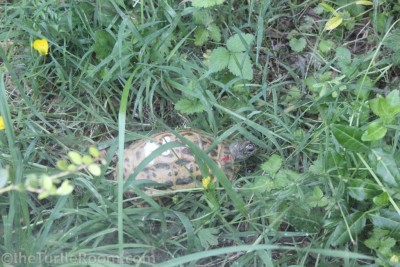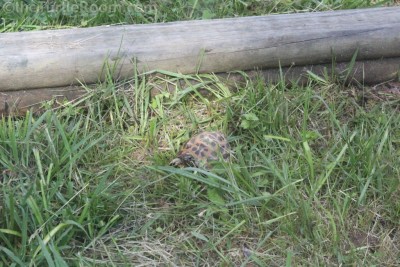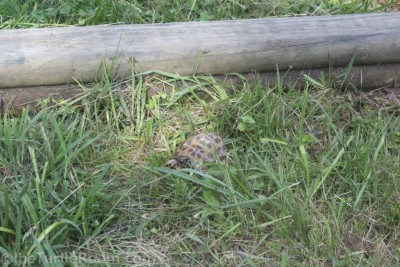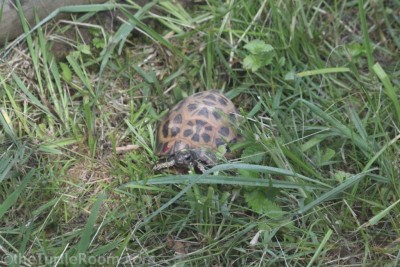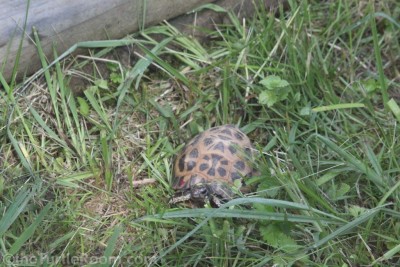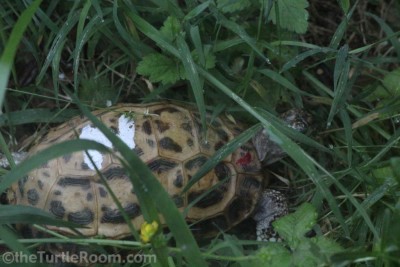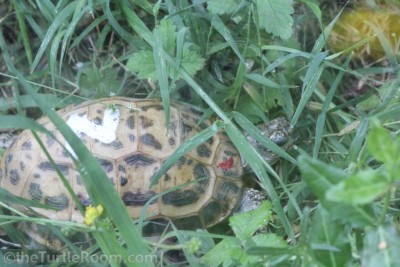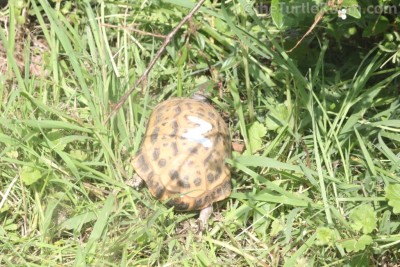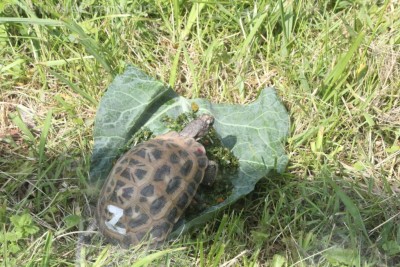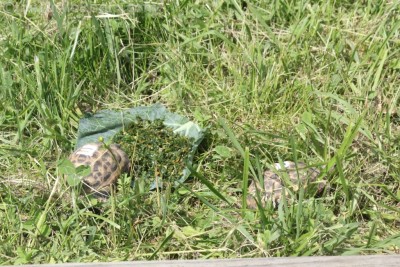Description and Identification
Spider Tortoises earn their common and Latin names from the radiating carapace markings that resemble a spider's web. The shell is a cream color, and the black pattern extends outward in all directions from the areola of each vertebral and pleural scute. Older adult specimens may lose their patterning with age and take on a uniform tan or cream color. Its head is proportionately small, with a darker brown or black color above, and the chin, neck and parts of the face are yellow. The plastron of Pyxis arachnoides oblonga is tan or yellowish in color and contains a flexible hinge and black markings on the bridge and edges of the plastron. P. a. oblonga can be differentiated from the other two subspecies through its plastron, as P. a arachnoides and P. a. bryoogi have no markings on their plastron. P. a. brygooi can most easily be differentiated from P. a. oblonga, having no plastral hinge or markings.
A 2011 study by Walker, R.C.J., et.al., has shown through remote data collection that vegetation loss continues unabated in the heart of this tortoise’s range. The study also revealed an actual mean tortoise decline of 10.8% between 2003 and 2011.
Distribution
The Spider Tortoise is found only in the arid region of the coastal areas of southwestern Madagascar, from the coast up to 10-50 kilometres inland going as far north as Morombe. It is sympatric with the Radiated Tortoise except for the northern extent of its range. The southern subspecies, Pyxis arachnoides oblonga, is found in extreme southeastern Madagascar. It can be found between the Menarandra River and Lake Anony.
Native Habitat
The Spider Tortoise is found in Mikea forest habitat in the north and in communities of xerophytic spiny vegetation with low irregular rainfall. Their habitat is a biologically unique ecoregion severely threatened by unsustainable subsistence agricultural practices such as livestock herding, charcoal production, and arable planting. This habitat consists of sandy areas with spiny vegetation close to the coast where Didiereaceae, a dry season deciduous spiny tree, and Ephorbia, a flowering spiny plant, dominate the landscape. They do not tend to utilize rocky areas as does the Radiated Tortoise, Astrochelys radiata.
Pyxis arachnoides ssp. may experience temperatures ranging from a low of 43F (6C) to a high of 108F (42C) in their natural range. The average temperatures range from 58F (14C) to 92F (33C) and the mean relative humidity is 78%. They seem to prefer temperatures in the low 80′s (27 to 29C).
Wild Diet
Pyxis arachnoides was only recorded as feeding during the wet months, a period of increased activity. The Spider Tortoise is omnivorous and in its arid habitat it has to be content with what it can find. Dried leaves, fallen fruit, and dead animals are on the menu; Spider Tortoises investigating cow dung to find insects has been reported. Grasses, leaves and succulents are what they find most in the wild.
For feeding Pyxis arachnoides ssp. in captivity, Michael Ogle, Assistant Curator of Reptiles, Knoxville Zoo will seasonally offer Opuntia fruit, but only occasionally since it is a relatively recent arrival to Madagascar; Opuntia cacti was brought to the Island some 300 years ago. Every two to three weeks during the warmest months, Michael adds some shredded cactus pad to their greens diet just for diversity's sake. The easiest succulents to grow and feed are various species/varieties of Sedum, which are readily found in garden centers during the warmer months and the tortoises love them (personal communication, 2012).
Behavior
The Southern Spider Tortoise appears from its favorite hideouts during the wet season. This emergence is most often triggered by heavy rains. During the dry season, the tortoise stays hidden under leaf litter, roots, sand or gravel. In captivity, P. a. oblonga displays these same behaviors, hiding in cooler and more arid conditions during the winter and emerging with increased heat, especially when their enclosure is misted. No solid data exists on longevity but estimated life span is believed to be up to 70 yrs.
Reproduction
When Pyxis arachnoides oblonga is active, it shows astonishing vivacity, runs around rapidly, and copulates noisily. The egg clutches are very small; generally only a single egg is laid. Incubation requires a diapause and hatching in the wild is stimulated by rain.
New methods in incubation have been utilized by Timothy Beard, of Tortuga Inn & Suites. Previously, eggs were warmed to 86F immediately after being laid, continuing this warming for 5 weeks. The eggs would then be cooled to 60-70F for 8 weeks before going back in the incubator for the duration. This year, the initial incubation period was removed and the eggs were cooled as before, but immediately after being laid. Then they went to the incubator and developed as normal, shortening the overall incubation period by 5-6 weeks. Such a result suggests the key is the diapause period and development occurs after this cooling period (personal communication, 2012).
This Care Guide is an external Care Guide. While it is possible this care guide may not be for the exact species you were looking for, it provides information suitable for your species. This Care Guide link will take you away from theTurtleRoom. We only link to care guides we trust. Thanks for visiting theTurtleRoom.org.
Care GuideIf you would like to contribute to the photo gallery of any turtle or tortoise species, please email us at [email protected]. You will be credited for any photos you contribute.
| Pyxis arachnoides oblonga |
| (Gray, 1869) |
| IUCN Red List: |
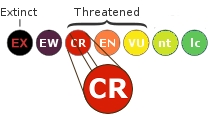 |
| Critically Endangered A4cd; E (2008) |
| Order: | Testudines |
| Suborder: | Cryptodira |
| Superfamily: | Testudinoidea |
| Family: | Testudinidae |
| Genus: | Pyxis |
| species: | arachnoides |
| subspecies: | oblonga |
| Other Common Names: |
| Kapila |
| CITES: | Appendix I |
Author:
Editors: Stephen J. Enders, Anthony Pierlioni, Chris Leone, Andrew S. Weber, Ben Forrest, and Andrew Hermes
Sources
Disclaimer: The Species Profiles - Natural History, Care Guide, and Photo Gallery database is an educational resource. It does not cover all Chelonian species in the world, nor does it include all the latest scientific information about the species covered. Though we edit our accounts for accuracy, we cannot guarantee all information in those accounts. While theTurtleRoom's staff and contributors provide references to books and websites that we believe are reputable, we cannot necessarily endorse the contents of references beyond our control.

This work by theTurtleRoom is licensed under a Creative Commons Attribution-NonCommercial-ShareAlike 4.0 International License.



